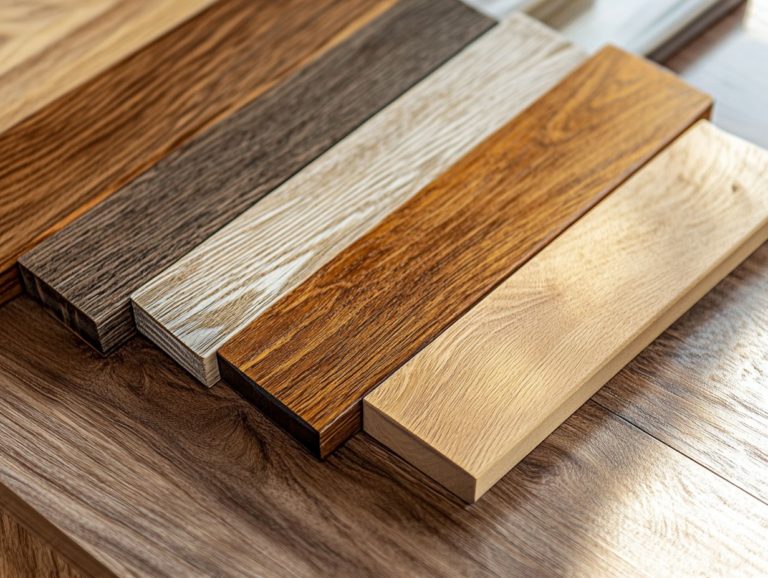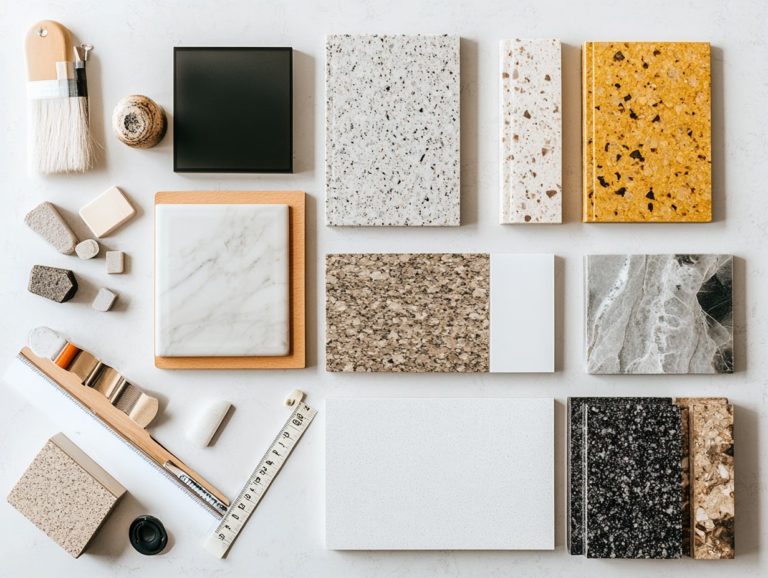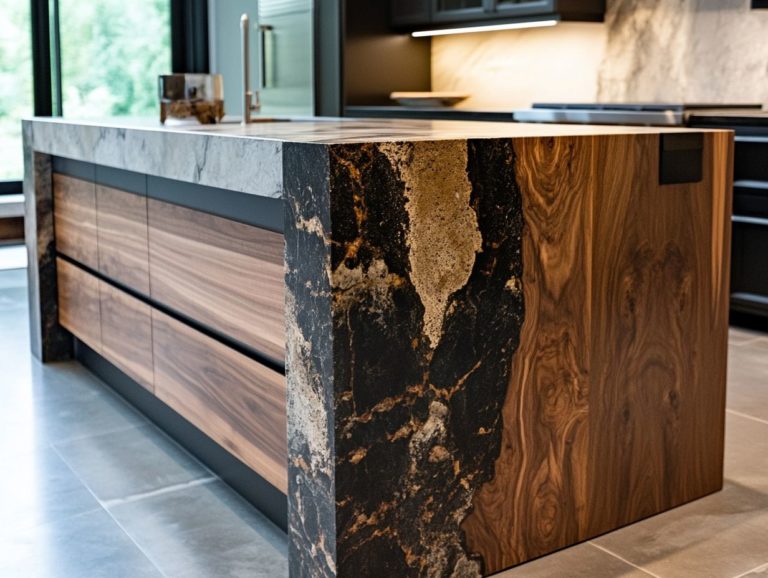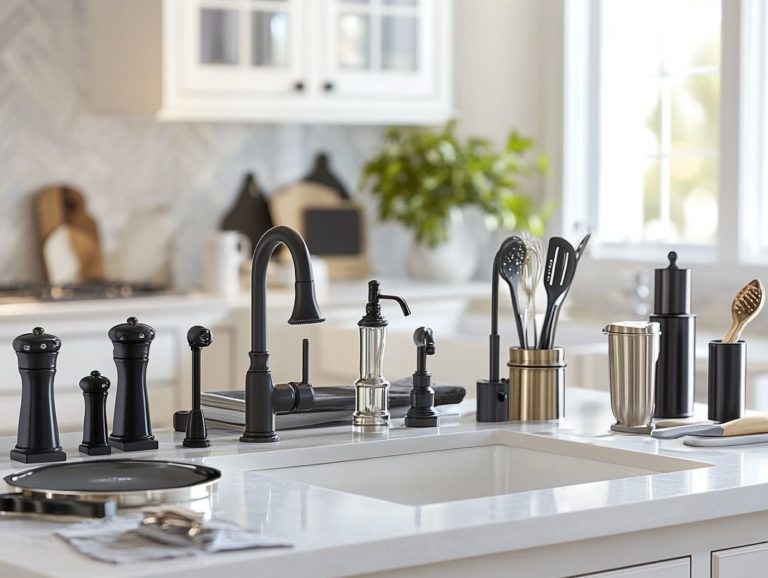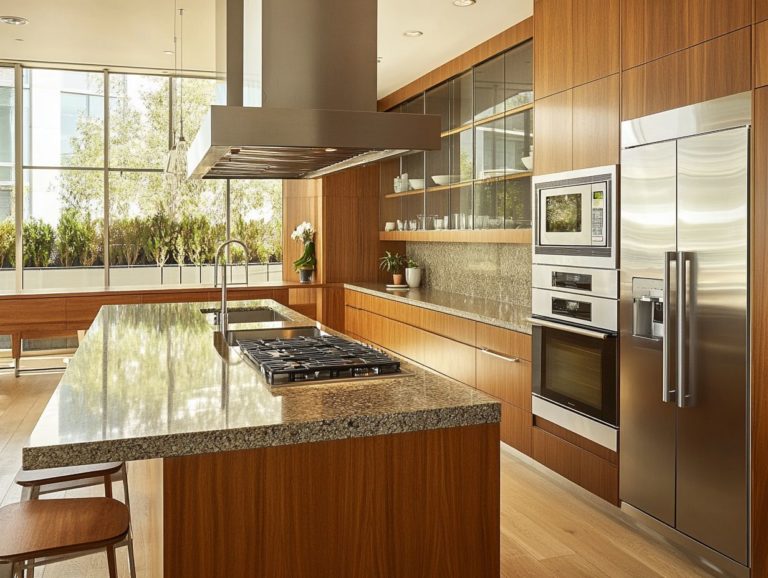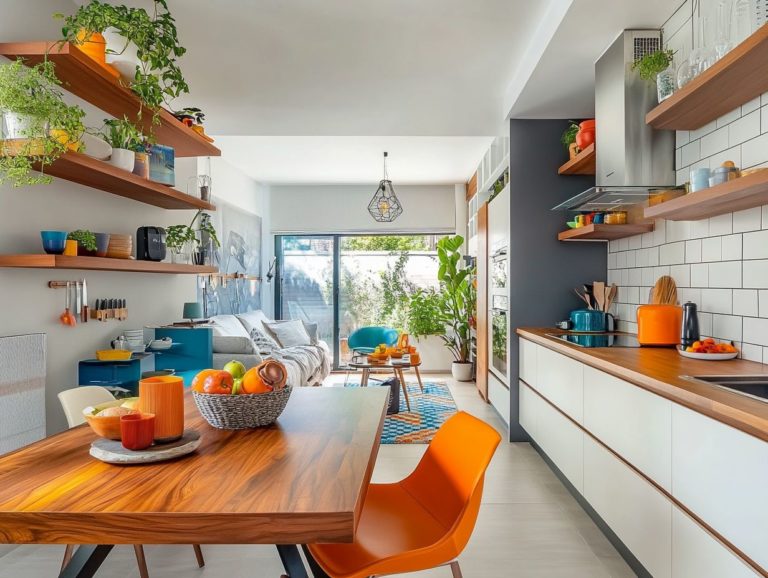The Benefits of Using Reclaimed Wood in Kitchens
Reclaimed wood transcends mere design choice; it embodies a sustainable solution that infuses your kitchen with character and warmth.
Delve into the myriad benefits of incorporating reclaimed wood, from its positive environmental impact to its distinct aesthetic allure. Uncover various types of reclaimed wood that are ideally suited for kitchen environments, along with innovative methods to seamlessly integrate them into your design.
You’ll also receive essential tips for maintaining and preserving these unique materials. Don’t miss out on the charm and sustainability that reclaimed wood brings to your kitchen!
Contents
- Key Takeaways:
- Benefits of Using Reclaimed Wood in Kitchens
- Types of Reclaimed Wood Available for Kitchens
- How to Incorporate Reclaimed Wood into Kitchen Design
- Caring for Reclaimed Wood in Kitchens
- Frequently Asked Questions
- What is reclaimed wood and why is it beneficial to use in kitchens?
- How is using reclaimed wood in kitchens better for the environment?
- What are some unique characteristics of reclaimed wood that make it suitable for kitchens?
- Is reclaimed wood durable and suitable for kitchen use?
- What are the maintenance requirements for using reclaimed wood in kitchens?
- Are there cost benefits to using reclaimed wood in kitchens?
Key Takeaways:
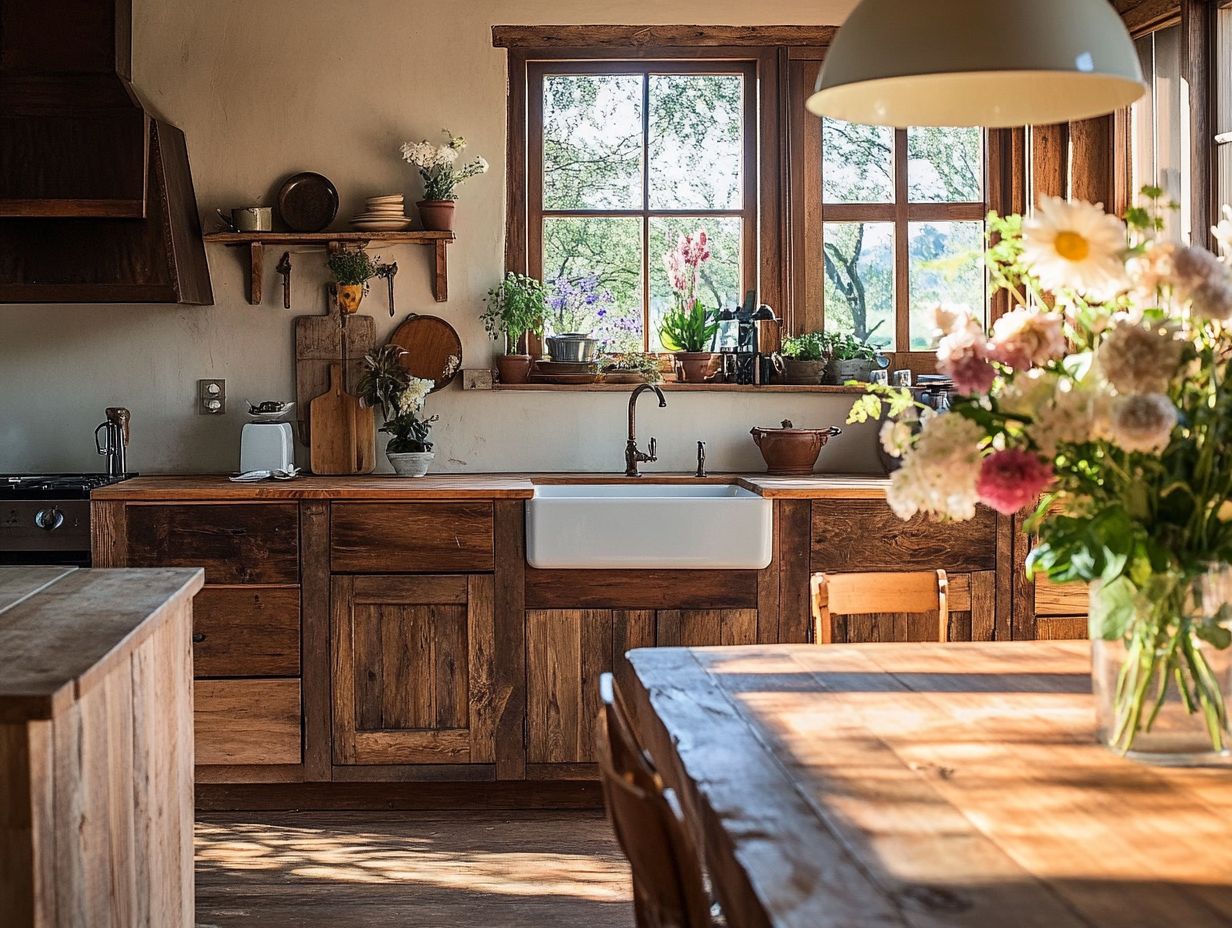
- Reclaimed wood reduces deforestation and carbon footprint.
- It adds unique rustic charm to kitchens.
- Using reclaimed wood can save costs and increase home value.
What is Reclaimed Wood?
Reclaimed wood is lumber salvaged from old buildings, like barns and factories, giving new life to materials that would otherwise contribute to environmental waste. This eco-friendly choice isn’t just beneficial for the planet; it also boasts rich historical value, making it a sought-after option for construction projects that emphasize thoughtful design.
Its unique appearance and impressive structural strength make reclaimed lumber appealing for various applications, including:
- Flooring
- Kitchen countertops
- Furniture
Homeowners looking to reduce their environmental impact while embracing the rustic charm of weathered wood will find it especially enticing. Sourcing reclaimed lumber involves the careful dismantling of aged structures that preserves their integrity and ensures minimal waste.
As more individuals turn to eco-friendly products, the demand for these renewable resources continues to grow. Builders and designers are increasingly prioritizing sustainability in their projects. Every piece of reclaimed wood tells a story, infusing spaces with character and a historical depth that new materials simply cannot replicate.
By opting for reclaimed wood, you not only help decrease deforestation but also contribute to a reduction in carbon emissions. It’s a responsible choice for those who wish to merge style with environmental responsibility.
Benefits of Using Reclaimed Wood in Kitchens
Embracing reclaimed wood in your kitchen designs presents a wealth of benefits, from its environmental merits to its distinct aesthetic allure. By choosing reclaimed materials, you champion eco-friendly choices, repurposing high-quality lumber and effectively decreasing the demand for new timber.
This conscious choice not only elevates the character of your kitchen but also opens the door to substantial cost savings in your home improvement endeavors.
Environmental Impact
The environmental impact of using reclaimed wood is overwhelmingly positive, as it promotes waste reduction and utilizes a renewable resource often sourced from historical structures. Choosing reclaimed lumber also helps conserve natural resources and supports sustainable materials certified by organizations like the Forest Stewardship Council, a group that ensures wood comes from responsibly managed forests.
This practice diverts potential waste from landfills and reduces the demand for new timber, which can lead to harmful deforestation and habitat loss. By utilizing reclaimed materials, you minimize the energy spent on processing and transporting fresh lumber, significantly reducing your carbon footprint.
By opting for products that comply with the guidelines established by the Forest Stewardship Council, you ensure responsible harvesting, promoting forest management that prioritizes ecological balance and the well-being of future generations.
Ultimately, embracing reclaimed wood fosters a circular economy where resources are repurposed, creating a sustainable cycle that benefits both the environment and society.
Unique Aesthetic
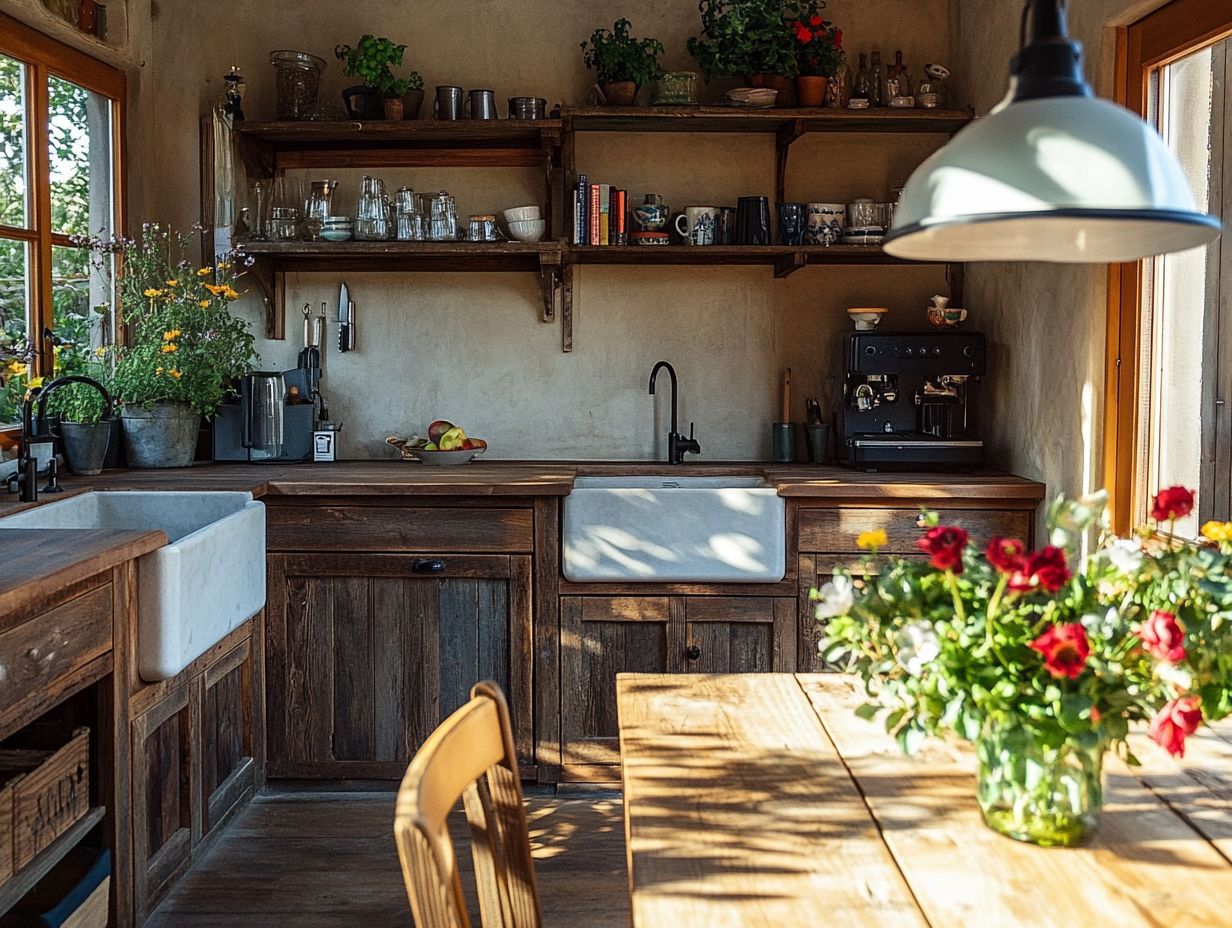
Reclaimed wood is truly a gem. It brings a rustic charm to any kitchen. Each piece tells its own story. Weathered surfaces and vintage lumber showcase distinct color variations and textures that simply can’t be replicated in new materials.
The natural patina, a shiny surface that develops over time, adds depth and warmth. This crafts a welcoming atmosphere in your space. Imagine elegantly aged barn wood countertops or creatively repurposed cabinets. These materials offer a timeless beauty that blends seamlessly with modern designs.
Their imperfections and irregularities evoke a sense of history. This transforms them from mere building materials into captivating focal points that draw admiration. Whether you incorporate this distinctive wood into open shelving or feature it in kitchen islands, its allure adds character. It invites conversation while anchoring your kitchen with an authentic touch.
Cost Savings
One of the most appealing aspects of reclaimed wood is the potential for significant cost savings in your home renovation projects. By utilizing recycled materials, you can often discover high-quality lumber at a fraction of the price of new, expensive options. This makes reclaimed wood a smart choice for your budget.
This affordable option doesn’t sacrifice quality. In fact, reclaimed wood often possesses resilience and character that new materials can’t match. Sourced from previously used structures, these robust materials have already weathered the test of time. They are ideal for long-lasting renovations.
Choosing reclaimed wood saves you money and is better for the environment. This choice is especially beneficial for those who value both environmental responsibility and the unique beauty that reclaimed wood brings to their homes.
Types of Reclaimed Wood Available for Kitchens
When you delve into the world of reclaimed wood for your kitchen, you’ll discover a diverse array of wood species. These not only boast exceptional durability but also elevate the beauty of your space.
You’ll find vintage lumber, antique barnwood, and favored choices like Douglas fir, oak, and pine. Each brings its own distinct features, making them ideal for a variety of kitchen designs.
Common Species and Features
Common species of reclaimed wood, such as oak, pine, and Douglas fir, each bring their own unique features and suitability for various applications.
Oak is highly valued for its strength and beautiful grain patterns. Pine presents a lighter appearance with a softer texture, making it perfect for those rustic kitchen designs you’ve always admired.
Douglas fir, on the other hand, is known for its durability and rich reddish-brown hues. It adds warmth and character to any space you envision.
These reclaimed woods support environmentally friendly building practices and carry historical significance. They often come from old structures that lend a compelling story to their appeal.
The interplay of textures and colors from each species creates stunning contrasts in your interior designs. Plus, the natural aging process enhances their charm and uniqueness. This makes reclaimed wood a top choice among designers and homeowners who appreciate both beauty and sustainability.
How to Incorporate Reclaimed Wood into Kitchen Design
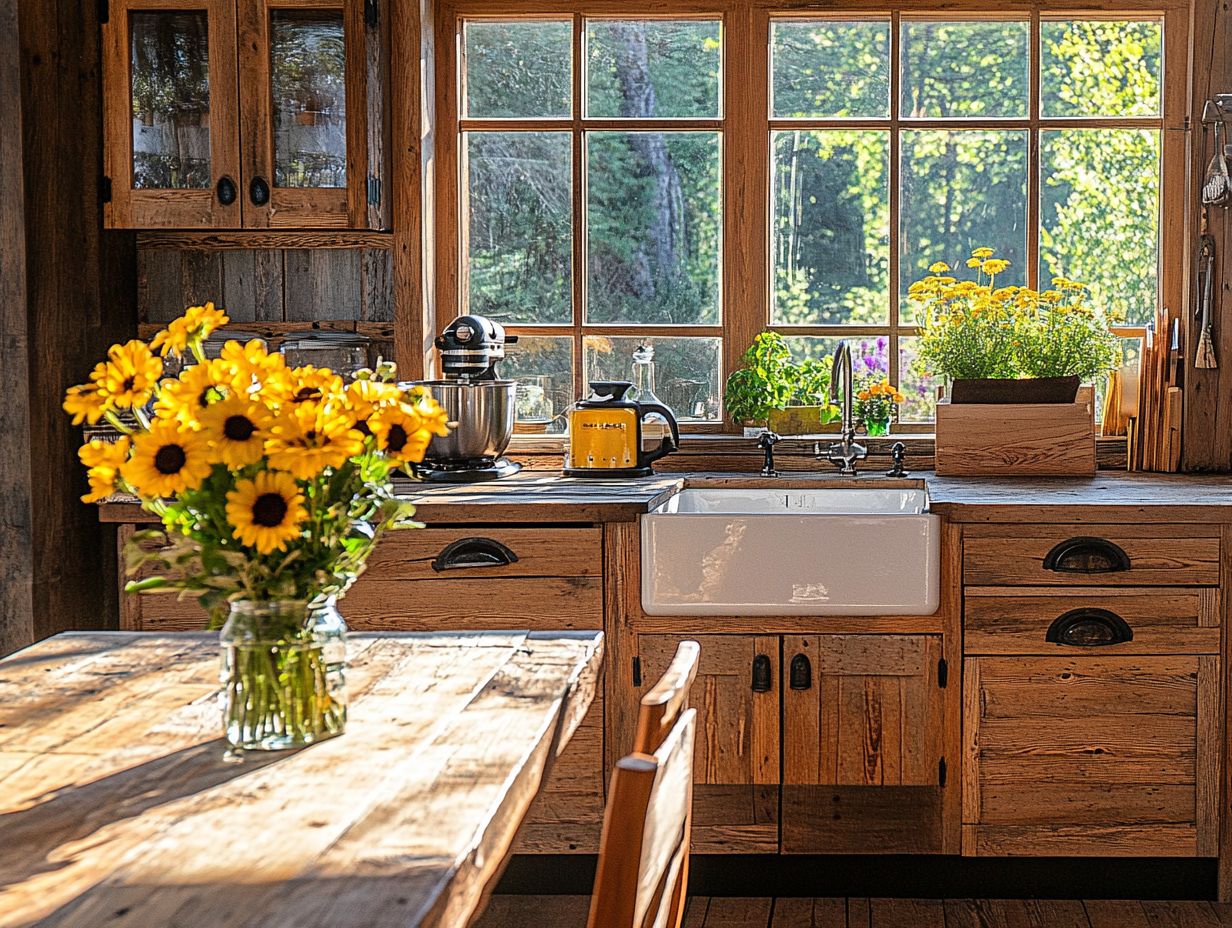
Incorporating reclaimed wood into your kitchen design can truly elevate the space. It presents an eco-friendly option that enhances both functionality and beauty.
Whether you opt for reclaimed wood flooring or distinctive kitchen countertops, the versatility of these materials enables you to explore creative applications. They align beautifully with sustainable building design principles.
Don’t miss out on transforming your kitchen today!
Ideas and Inspiration
When you seek inspiration to incorporate reclaimed wood into your kitchen designs, you’ll discover a wealth of ideas that elevate both the aesthetic and functionality of the space.
Imagine opting for open-shelf designs that beautifully showcase reclaimed wood. You can also integrate it into cabinetry to craft a captivating focal point. Consider using reclaimed wood for your island countertop as well. It exudes warm, rustic charm and serves as a durable work surface, aligning perfectly with the principles of balance and harmony in interior design.
Mixing reclaimed wood with modern appliances creates a striking contrast. Sturdy paneling can seamlessly unify various elements within the room. Don’t overlook the potential of integrating reclaimed features in unexpected places like backsplashes or ceiling beams.
Using reclaimed wood tells a unique story and adds charm to your home, inviting visual interest and a distinctive narrative into the heart of your kitchen.
Caring for Reclaimed Wood in Kitchens
Caring for reclaimed wood in your kitchen is crucial for preserving its beauty and durability. Proper maintenance ensures it remains a stunning feature in your home for years to come.
Regular cleaning and periodic pest inspections are essential to prevent damage. Understanding ways to keep the wood looking good will enhance the longevity of these resilient materials.
Tips for Maintenance and Preservation
- Regularly clean with gentle, non-abrasive products. This prevents damage while enhancing the wood’s natural finish.
- Incorporate a weekly dusting routine with a microfiber cloth to remove particles that could scratch the surface.
- For deeper cleaning, mix mild soap with warm water. Apply it with a soft cloth to rejuvenate its luster without compromising its integrity.
- Be mindful of excess moisture; promptly wipe up spills and use coasters to prevent water rings.
- Apply a quality wood conditioner every few months. This product protects and nourishes the wood, ensuring it remains a stunning focal point in your kitchen.
Don’t wait! Start your cleaning routine today to ensure your reclaimed wood looks its best.
Frequently Asked Questions
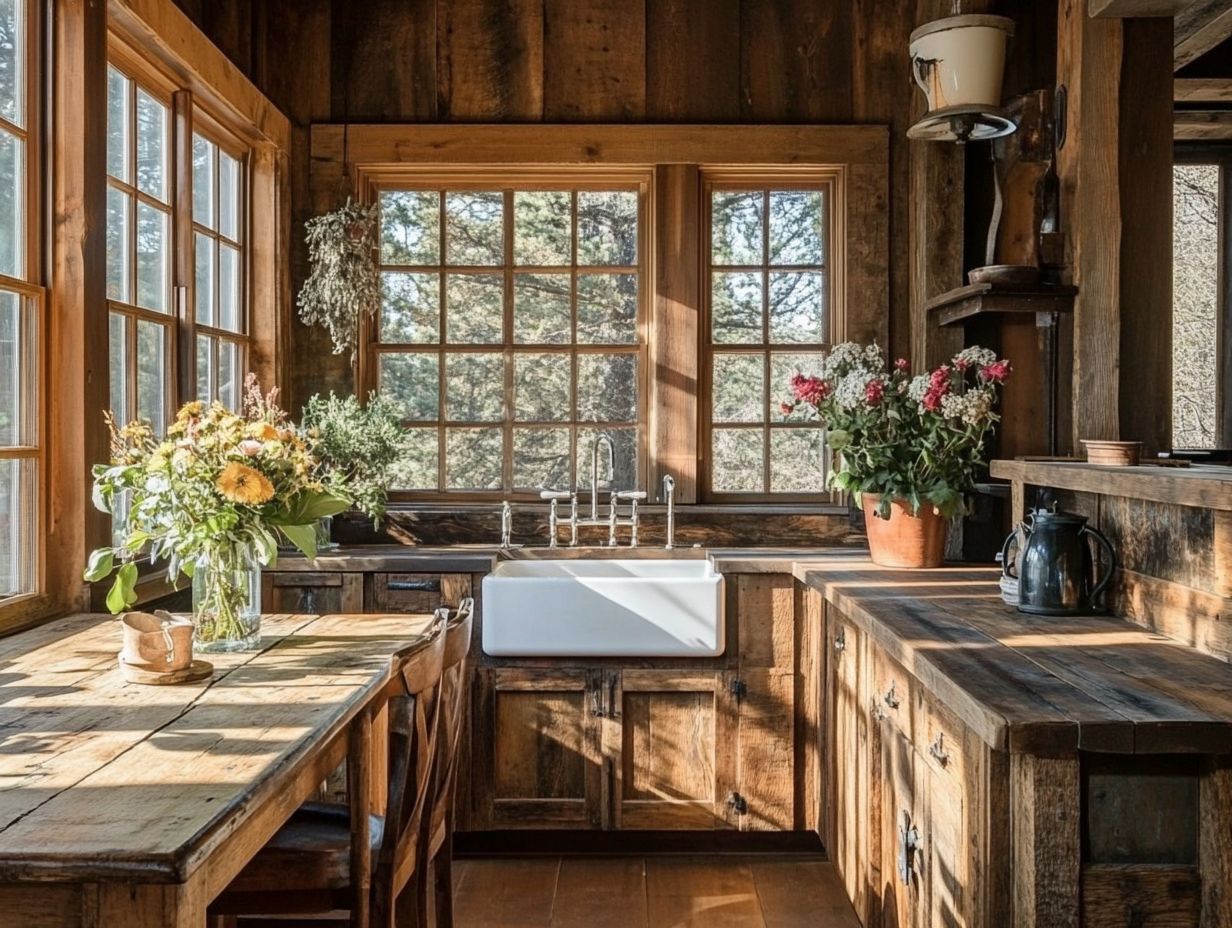
What is reclaimed wood and why is it beneficial to use in kitchens?
Reclaimed wood is reused wood from old buildings, barns, and other structures. It is beneficial because it is environmentally friendly, has unique character, and can add warmth and charm to your kitchen.
How is using reclaimed wood in kitchens better for the environment?
Reclaimed wood reduces the demand for new lumber, helping to preserve natural resources and reduce deforestation. It also prevents old wood from ending up in landfills, reducing waste and pollution.
What are some unique characteristics of reclaimed wood that make it suitable for kitchens?
Reclaimed wood has a weathered and distressed look with unique knots, grains, and colors. It carries history and a story behind it, adding a personal touch to your kitchen.
Is reclaimed wood durable and suitable for kitchen use?
Yes, reclaimed wood is often stronger and more durable than new wood due to its age and quality. It is treated and sealed to prevent warping, rotting, and insect infestations, making it perfect for kitchen cabinets and countertops.
What are the maintenance requirements for using reclaimed wood in kitchens?
Reclaimed wood in kitchens requires regular cleaning and sealing to maintain its beauty and durability. Its natural imperfections also make it forgiving of scratches and stains.
Are there cost benefits to using reclaimed wood in kitchens?
While prices may vary, using reclaimed wood can be more cost-effective than buying new wood. It adds value to your home and can potentially save you money on future renovations.
